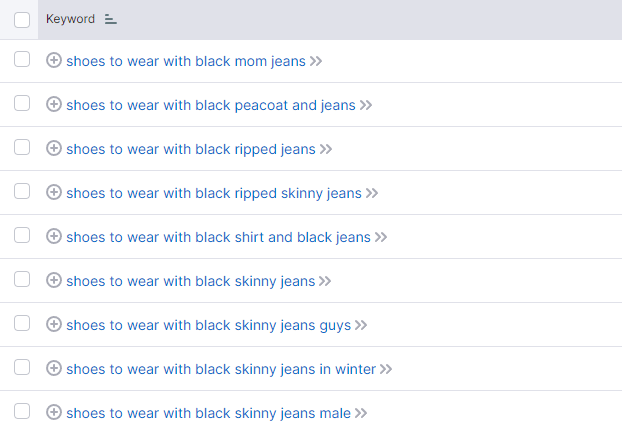Learn how to grow your organic reach with keyword clustering in this guide from our award-winning team. Discover the benefits, see examples, and learn how to get started with keyword clustering for SEO now!
What is keyword clustering?
Instead of focusing your content or web page around a single keyword or keyword phrase, keyword clustering involves researching similar, related keywords and grouping them together thematically to help search engines form better connections between each piece of website content.
Why is keyword clustering important for SEO?
Keyword clustering is important for SEO because it:
- Expands your organic reach by targeting other relevant keywords
- Anticipates your audience’s next search intent, like learning how to do something after understanding what it is and why it’s valuable
- Makes your website content manageable by creating one page to target multiple relevant search terms vs. one page for each term
You can learn about its benefits in-depth below:
- It gives you authority: The more you demonstrate your knowledge of a topic or industry, the easier it is for Google to make those connections, too. When Google sees you know what you’re talking about and can offer searchers genuine value, the algorithm makes it easier for searchers to find you.
- It improves your searchability: Infusing a single page or piece of content with multiple high-value keywords improves your chances of discoverability. You can niche down into less competitive areas, an especially helpful strategy if you’re new to SEO and keyword targeting, or you work in an industry with heavy web traffic to contend with.
- It’s a cheat sheet for content creation and web design: Successful keyword clustering can almost act like a cheat sheet for design and content creation. As you’ve seen, cluster pillars and subtopics lend themselves naturally to long-form article structures and website design. It’s also a great way to use internal linking.
- It gives you better audience insight: Cluster creation gives you unique insight into what your target shoppers and audience search for, which can help you create more accurate marketing persona profiles and offer more valuable content.
Examples of keyword clusters

Take a look at these examples and how keyword clustering can help you build a more comprehensive and trust-building approach to content creation and web design.
A fashion boutique is trying to rank for the keyword “shoes to wear with jeans.” While using keyword clustering tools to research additional keywords for their cluster, they find a lot of keywords ranking for specific jean types, including:
- “Shoes to wear with skinny jeans”
- “Shoes to wear with mom jeans”
- “Shoes to wear with flare jeans”
- “Shoes to wear with black jeans”
- “Shoes to wear with men’s jeans”
By clustering these together, the boutique owner gets a better idea of what customers want from their online store and what type of page layout would be the most helpful.
You can also use keyword clustering for writing website copy like blog posts or how-to guides.
If a local designer wants to focus her advertising efforts on the upcoming wedding season, she might use “wedding invitations” as her cluster pillar. Related keywords could include things like:
- “Wedding invitation templates”
- “How to address wedding invitations”
- “Custom wedding invitations”
- “When to send wedding invitations”
Armed with this information, she gets to work creating a comprehensive guide for wedding invitations, with subtopics breaking down the different types of invitations — like custom vs. template invitations — as well as wedding invitation etiquette, like how to format them, when to send them, and how to address them.
Targeting all these keywords at once increases her chance of being found while establishing herself as an expert in invitation design. Plus, such a thorough guide can really bring value to potential customers, creating a strong foundation to build a customer-client relationship.
How to cluster keywords
Learn how to cluster keywords now:
Research relevant keywords
Start by researching relevant keywords.
Focus on the words and phrases with high search volume but low search competition to improve your ranking chances. Go beyond one and two-word keywords — more than half of web searches are four words or longer, called long-tail keywords, and they’re ideal for creating targeted clusters.
Look for themes
Review your collected keywords to identify common themes, and see which keywords fit naturally into groups of related content. You can do this manually with mapping and a spreadsheet or use AI tools.
Identify the pillar
Identify your cluster’s “pillar” or core topic. This will act as the center of your cluster, while all other keywords are supporting information or related subtopics.
Group subtopics
If you use keyword clustering for website design, your pillar keyword might be a landing page, while other cluster keywords are subpages. In an article, your pillar would be the article’s headline and overall topic, while each H2 and H3 section beneath would represent a different keyword from the cluster.
Put them to work
Approach keyword clusters as creatively and flexibly as you do individual keywords.
Assign clusters to whatever part of your digital marketing strategy they fit best, like metadata, blogs, page construction, or specific marketing campaigns. Consider the context surrounding those keyword clusters, like how often they appear on individual platforms and which marketing segments or demographics use those keywords the most.
This is just an overview of keyword cluster creation.
Once you’ve mastered the basic principles, talk to a marketing expert about the more advanced parts of clustering, like the difference between soft and hard keyword clusters, SERP-based clustering vs. clustering for natural language processing, and more.
Tips for creating and using clustered keywords
If keyword clustering sounds like the missing piece your SEO strategy needs, these tips can help:
Have a keyword strategy
Your keyword strategy should include regularly generating keyword ideas, monitoring keyword search changes, and updating keyword usage accordingly. Considering Google’s algorithm changes an estimated 500 to 600 times yearly, what ranks today won’t necessarily rank next week — or even tomorrow.
Refresh existing content
Updating and refreshing your existing web copy with up-to-date links, better ranking keywords, fresh content, and new visuals can increase your organic traffic by over 100%.
Don’t talk to robots
While algorithms might be how your audience finds you, don’t create content for robots.
Balancing keyword integration with natural language can be challenging enough when working with a few keywords at a time — working with an entire cluster takes an even more intentional approach. Don’t keyword stuff, or audiences and search engines will pass you by for more valuable content elsewhere.
Consider searcher intent
Just because some keywords fit together thematically doesn’t mean they belong in the same cluster.
For example, if you sell heavy-duty tilling equipment for commercial farmers, you wouldn’t include keywords like “how to till mulch” or “tilling a home garden” in your “tilling equipment” keyword cluster since your target audience wouldn’t find the information useful for their commercial applications.
Let the pros at SEO.com handle your SEO strategy
Keyword clustering can be a helpful way to build trust and authority with your audience, improve your searchability, and get the most use out of your content and website as possible. But this SEO strategy only works if you put the time and research into it, including ongoing keyword maintenance.
Whether you need comprehensive SEO services or are just looking for a quick way to refresh your existing copy’s keyword content, SEO.com is here to help. Learn more today!
Let’s Drive Results Together

Meet
Connect with us, today!
Writers

Related Resources
- What is Full-Service SEO?
- What is Google Analytics?
- What is Google Local Pack? (And How to Rank for It)
- What is Google Trends?
- What is Keyword Difficulty? (And How to Use Keyword Difficulty for SEO)
- What is Keyword Ranking?
- What is Keyword Stuffing? (And Why It’s Bad News for SEO)
- What is Link Building? Your Guide to Quality Link Building
- What is Robots.txt File? Learn the Basics with SEO Pros
- What is White-Hat SEO? How to Rank While Following the Rules


